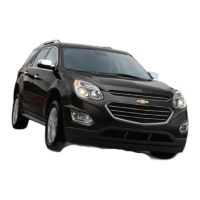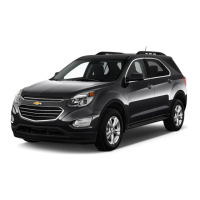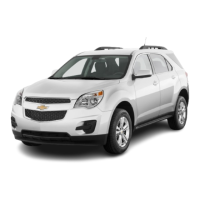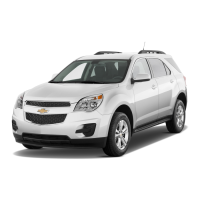Do you have a question about the Chevrolet Equinox 2012 and is the answer not in the manual?
Overview of the vehicle's front dashboard controls and displays, including levers and buttons.
Key features for initial vehicle operation and information, including remote keyless entry.
Details on various vehicle features like radio, Bluetooth, cruise control, and navigation.
Information on vehicle keys, locks, remote entry systems, and remote vehicle start.
Operation of power door locks, safety locks, and manual door unlocking.
Manual and power liftgate operation, including safety warnings.
Operation of power windows, express down feature, and window lockout.
Proper installation and adjustment of front and rear head restraints for safety.
Seat adjustment, lumbar support, power seat controls, and memory seat features.
Proper use, wear, and safety of seat belts for all occupants.
Details on airbag types, operation, deployment, and important safety precautions.
Guidance on selecting, installing, and using child safety seats for various age groups.
Location and operation of interior storage areas like glove box and center console.
Information on cargo cover, tie-downs, and convenience nets for rear storage.
Use, adjustment, and safety guidelines for roof rack cross rails.
Steering wheel adjustment and controls, horn, windshield wipers, and washer operation.
Explanation of dashboard warning lights, gauges, and indicators and their meanings.
Operation of the Driver Information Center (DIC) and interpretation of vehicle messages.
Controls for headlamps, fog lamps, turn signals, and automatic headlamp system.
Operation of reading lamps, dome lamps, and instrument panel illumination.
Information on entry lighting and battery load management features.
Overview of infotainment system features and important safety warnings.
AM/FM radio operation, CD player, satellite radio, and control buttons.
Details on CD and MP3 playback, USB connectivity, and auxiliary devices.
Bluetooth connectivity, voice recognition, and phone controls for hands-free calls.
Operation of heating, cooling, defrosting, and ventilation systems.
How to direct airflow using interior air outlets and thumbwheel controls.
Procedures for inspecting and replacing the passenger compartment air filter.
Guidance on distracted driving, defensive driving, and drunk driving safety.
Procedures for new vehicle break-in, ignition positions, and starting the engine.
Operation of automatic transmission, manual mode, and fuel economy.
Details on All-Wheel Drive (AWD) system operation and its interaction with other systems.
Information on Antilock Brake System (ABS), parking brake, and brake assist features.
Operation of Traction Control System (TCS) and StabiliTrak® system.
How to set, resume, and use cruise control safely on various roads.
Forward Collision Alert (FCA) and Ultrasonic Parking Assist system functions.
Recommended fuel types, octane ratings, E85 usage, and filling the tank.
Importance of dealer service and using genuine GM parts for vehicle maintenance.
Guidance for performing basic vehicle checks and service tasks safely.
Procedures for checking, adding, and selecting the correct engine oil.
Coolant levels, types, and system maintenance procedures.
Causes, warnings, and actions to take for engine overheating.
Disc brake operation, wear indicators, and brake fluid checks.
Safety warnings, vehicle storage, and battery maintenance.
Information on tire maintenance, rotation, inspection, and replacement.
Importance of proper tire inflation and consequences of under/overinflation.
How the TPMS works and its warning indicators for low pressure.
Safe procedures for jump starting a vehicle with a dead battery.
General towing information and guidelines for transporting the vehicle.
Tips for maintaining the vehicle's exterior finish and paint.
Cleaning techniques and precautions for the vehicle's interior surfaces.
Importance of regular maintenance for vehicle performance and value.
Required maintenance intervals for normal and severe driving conditions.
Specifies approved fluids, lubricants, and replacement parts for the vehicle.
Section for recording service history and retaining maintenance receipts.
Information on Vehicle Identification Number (VIN) and service parts label.
Capacities and specifications for engine cooling, oil, fuel, and transmission.
Diagrams showing drive belt routing for 2.4L L4 and 3.0L V6 engines.
Steps for resolving customer concerns with dealership or GM.
Procedures for reporting safety defects to government and General Motors.
Information on event data recorders and vehicle data privacy policies.
Overview of OnStar system, services, and additional information.
Instructions for using the vehicle's navigation system and voice commands.
FCC and Industry Canada compliance statement for vehicle radio frequency systems.
General introduction to the OnStar system and its key features.
Details on Emergency, Security, Navigation, Connections, and Diagnostics services.
Further details on OnStar services, system operation, and potential issues.
Overview of the vehicle's front dashboard controls and displays, including levers and buttons.
Key features for initial vehicle operation and information, including remote keyless entry.
Details on various vehicle features like radio, Bluetooth, cruise control, and navigation.
Information on vehicle keys, locks, remote entry systems, and remote vehicle start.
Operation of power door locks, safety locks, and manual door unlocking.
Manual and power liftgate operation, including safety warnings.
Operation of power windows, express down feature, and window lockout.
Proper installation and adjustment of front and rear head restraints for safety.
Seat adjustment, lumbar support, power seat controls, and memory seat features.
Proper use, wear, and safety of seat belts for all occupants.
Details on airbag types, operation, deployment, and important safety precautions.
Guidance on selecting, installing, and using child safety seats for various age groups.
Location and operation of interior storage areas like glove box and center console.
Information on cargo cover, tie-downs, and convenience nets for rear storage.
Use, adjustment, and safety guidelines for roof rack cross rails.
Steering wheel adjustment and controls, horn, windshield wipers, and washer operation.
Explanation of dashboard warning lights, gauges, and indicators and their meanings.
Operation of the Driver Information Center (DIC) and interpretation of vehicle messages.
Controls for headlamps, fog lamps, turn signals, and automatic headlamp system.
Operation of reading lamps, dome lamps, and instrument panel illumination.
Information on entry lighting and battery load management features.
Overview of infotainment system features and important safety warnings.
AM/FM radio operation, CD player, satellite radio, and control buttons.
Details on CD and MP3 playback, USB connectivity, and auxiliary devices.
Bluetooth connectivity, voice recognition, and phone controls for hands-free calls.
Operation of heating, cooling, defrosting, and ventilation systems.
How to direct airflow using interior air outlets and thumbwheel controls.
Procedures for inspecting and replacing the passenger compartment air filter.
Guidance on distracted driving, defensive driving, and drunk driving safety.
Procedures for new vehicle break-in, ignition positions, and starting the engine.
Operation of automatic transmission, manual mode, and fuel economy.
Details on All-Wheel Drive (AWD) system operation and its interaction with other systems.
Information on Antilock Brake System (ABS), parking brake, and brake assist features.
Operation of Traction Control System (TCS) and StabiliTrak® system.
How to set, resume, and use cruise control safely on various roads.
Forward Collision Alert (FCA) and Ultrasonic Parking Assist system functions.
Recommended fuel types, octane ratings, E85 usage, and filling the tank.
Importance of dealer service and using genuine GM parts for vehicle maintenance.
Guidance for performing basic vehicle checks and service tasks safely.
Procedures for checking, adding, and selecting the correct engine oil.
Coolant levels, types, and system maintenance procedures.
Causes, warnings, and actions to take for engine overheating.
Disc brake operation, wear indicators, and brake fluid checks.
Safety warnings, vehicle storage, and battery maintenance.
Information on tire maintenance, rotation, inspection, and replacement.
Importance of proper tire inflation and consequences of under/overinflation.
How the TPMS works and its warning indicators for low pressure.
Safe procedures for jump starting a vehicle with a dead battery.
General towing information and guidelines for transporting the vehicle.
Tips for maintaining the vehicle's exterior finish and paint.
Cleaning techniques and precautions for the vehicle's interior surfaces.
Importance of regular maintenance for vehicle performance and value.
Required maintenance intervals for normal and severe driving conditions.
Specifies approved fluids, lubricants, and replacement parts for the vehicle.
Section for recording service history and retaining maintenance receipts.
Information on Vehicle Identification Number (VIN) and service parts label.
Capacities and specifications for engine cooling, oil, fuel, and transmission.
Diagrams showing drive belt routing for 2.4L L4 and 3.0L V6 engines.
Steps for resolving customer concerns with dealership or GM.
Procedures for reporting safety defects to government and General Motors.
Information on event data recorders and vehicle data privacy policies.
Overview of OnStar system, services, and additional information.
Instructions for using the vehicle's navigation system and voice commands.
FCC and Industry Canada compliance statement for vehicle radio frequency systems.
General introduction to the OnStar system and its key features.
Details on Emergency, Security, Navigation, Connections, and Diagnostics services.
Further details on OnStar services, system operation, and potential issues.
| Brand | Chevrolet |
|---|---|
| Model | Equinox 2012 |
| Category | Automobile |
| Language | English |












